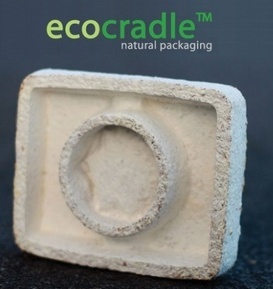
The styrofoam that is usually used in packaging is basically solidified oil — not so good for the environment. Ecocradle, by contrast, takes hardly any energy to make. It starts as agricultural byproducts — rice hulls and cotton burrs, for example. These are then seeded with the roots of mushrooms, which grow miles of white fibers that digest the byproducts and turn them into a white, foamlike substance. It can replace your usual synthetic foams, while using only 1/10th of the energy.
By using mycelium and agricultural by-products, they utilize materials that are environmentally low-impact, 100 percent biodegradable and renewable, and are part of a healthy ecosystem. Unlike other bio-plastics, our technology isn’t based on turning food or fuel crops into materials; only using inedible crop waste to create the products.
The way they produce EcoCradle™ uses significantly less energy than the manufacturing of synthetic foams. This is because it harnesses mycelium’s ability to self assemble lignin and cellulose into strong bio-composites, thus growing material without a lot of heat, pressure, or energy. They used Life Cycle Assessment (LCA) tools while designing the manufacturing system, to optimize every step.
So how is it grown? They grow EcoCradle™ using mycelium, a fungal network of threadlike cells. This mycelium grows around agricultural by-products like buckwheat husks, oat hulls, or cotton burrs to any shape or mould. In 5 – 7 days, in the dark, with no watering, and no petrochemical inputs, the mycelium envelops the by-products, binding them into a strong and beautiful packaging part. Inside every cubic inch of EcoCradle™, there’s a matrix of 8 miles of tiny mycelial fibers! At the end of the process, they treat EcoCradle™ with heat to stop the growth so there will never be any spores.
Oh yeh, even Dell uses it to ship their laptops in.

Comments by our Users
Be the first to write a comment for this item.